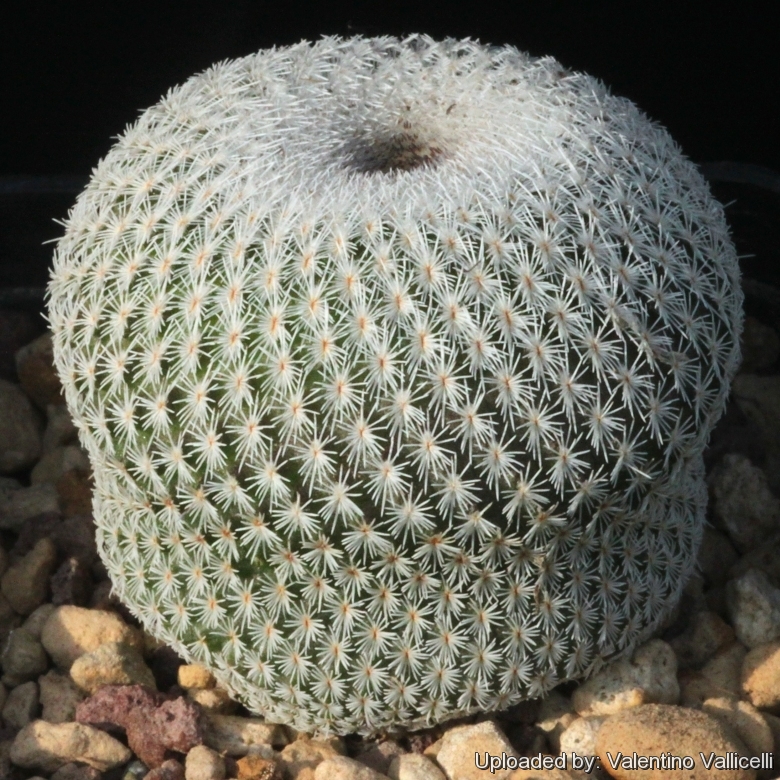
Epithelantha ilariae Photo by: Valentino Vallicelli
Origin and Habitat: Epithelantha ilariaeSN|18603]]SN|18603]] is found in Mexico from the southern slopes of Sierra de Obayos, around 50 km north of Monclova, Coahuila, and its distribution is a sort of wide band which ends north of Montemorelos, Nuevo Leon, and includes the small sierras (mountain chains) which surround the metropolitan area of Monterrey City, Nuevo Leon.
Altitude range: E. ilariae is the species of Epithelantha which grows at the lowest altitude, as it is found between 300 and 570 m above sea level.
Habitat end ecology: E. ilariae grows on semi-elevated slopes, between rocks on gravels mixed with earth containing organic compounds. A small part of the populations of E. ilariae are threatened by habitat degradation, exploratory works for the detection of deposits of natural gas, as well as the impact of annexed pipelines, and associated infrastructure, extraction of stone for manufacturing and building materials, quarry, as well as by grazing animals (cows and goats)
Associated species: Mammillaria lasiacanthaSN|9075]]SN|9075]], Coryphantha sp., Echinocereus enneacanthusSN|7930]]SN|7930]], Ariocarpus retususSN|2079]]SN|2079]] subsp. Trigonus, Etc.
Synonyms:
Description: Epithelantha ilariaeSN|12641]]SN|18603]] is a controversial species very similar in its morphology to Epithelantha bokeiSN|18603]]SN|12641]], but many characteristics separate the two species. The most important characteristic which distinguishes E. ilariae from E. bokei is the lack of evident denticles on the spine margins, which is a peculiar characteristic of E. bokei.
Stems: Flattened, regularly shaped, larger than 6 cm.
Radial spines: 30-52, distributed on 2-3 superposed layers. The spines have an elliptic section, instead of an applanate section as in E. bokei. The spine epidermis of E. ilariae is evidently waxy-white, especially during the juvenile phase, in E. bokei it is only slightly waxy or not at all.
Flowers The flowering period of E. bokei is March/July, whilst the flowering period of E. ilariae is March/October.
Bibliography: Major references and further lectures
1) "Libretto Epithelantha inglese.indd" - Kakteenfreunde-Basel http://www.kakteenfreunde-basel.ch/pdf/Epithelantha%20English.pdf
2) Manuel Nevarez de los Reyes "Notes about some threats to Epithelantha ilariae in three of its natural locations" Acta Succulenta 2(1): 78-90 2014
3) Anderson E.F. (2001), The Cactus Family, Timber Press Inc. USA.
4) Donati D. & Zanovello C. (2010), "Epithelantha F.A.C. Weber ex Britton & Rose Nuovi dati su ontogenia, fertilita, simpatria e revisione del genere", in Piante Grasse 30(4): 165-187.
5) Donati D. & Zanovello C., 2011, "Epithelantha 2011", Cactus Trentino Sudtirol: 64 pp.
6) NORMA Oficial Mexicana NOM-059-SEMARNAT-2010, "Proteccion ambiental-
Especies nativas de Mexico de flora y fauna silvestres-Categorias de riesgo y
especificaciones para su inclusion, exclusion o cambio-Lista de especies en
riesgo." Diario Oficial de la Federacion, 30 de diciembre de 2010.
7) Epithelantha ilariae: D.Donati & C.Zanovello, in Piante Grasse 30(4): 165-187 (2010)
8) Benjamin Catarino Morales, "Epithelantha of Coahuila ? part 1" Xerophilia Volume 3, No. 1 (8): 31-40 March 2014
 Epithelantha ilariae Photo by: Valentino Vallicelli
Epithelantha ilariae Photo by: Valentino Vallicelli Epithelantha ilariae Photo by: Valentino Vallicelli
Epithelantha ilariae Photo by: Valentino Vallicelli Epithelantha ilariae Photo by: Valentino Vallicelli
Epithelantha ilariae Photo by: Valentino VallicelliSend a photo of this plant.The gallery now contains thousands of pictures, however it is possible to do even more. We are, of course, seeking photos of species not yet shown in the gallery but not only that, we are also looking for better pictures than those already present.
Read More...














